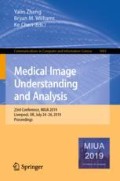Abstract
The fetal brain undergoes extensive morphological changes throughout pregnancy, which can be visually seen in ultrasound acquisitions. We explore the use of convolutional neural networks (CNNs) for the segmentation of multiple fetal brain structures in 3D ultrasound images. Accurate automatic segmentation of brain structures in fetal ultrasound images can track brain development through gestation, and can provide useful information that can help predict fetal health outcomes. We propose a multi-task CNN to produce automatic segmentations from atlas-generated labels of the white matter, thalamus, brainstem, and cerebellum. The network as trained on 480 volumes produced accurate 3D segmentations on 48 test volumes, with Dice coefficient of 0.93 on the white matter and over 0.77 on segmentations of thalamus, brainstem and cerebellum.
Access this chapter
Tax calculation will be finalised at checkout
Purchases are for personal use only
Notes
- 1.
Due to the size of this network, we used a batch size of 1 volume for training.
References
Pistorius, L.R., et al.: Grade and symmetry of normal fetal cortical development: a longitudinal two-and three-dimensional ultrasound study. Ultrasound Obstet. Gynecol. 36(6), 700–708 (2010)
Studholme, C.: Mapping fetal brain development in utero using magnetic resonance imaging: the Big Bang of brain mapping. Annu. Rev. Biomed. Eng. 13(1), 345–368 (2011)
Namburete, A.I.L., Stebbing, R.V., Kemp, B., Yaqub, M., Papageorghiou, A.T., Noble, J.A.: Learning-based prediction of gestational age from ultrasound images of the fetal brain. Med. Image Anal. 21(1), 72–86 (2015)
Kuklisova-Murgasova, M., et al.: Others: a dynamic 4D probabilistic atlas of the developing brain. NeuroImage 54(4), 2750–2763 (2011)
Gholipour, A., et al.: A normative spatiotemporal MRI atlas of the fetal brain for automatic segmentation and analysis of early brain growth. Sci. Rep. 7, 476 (2017)
Yaqub, M., et al.: Volumetric segmentation of key fetal brain structures in 3D ultrasound. In: Wu, G., Zhang, D., Shen, D., Yan, P., Suzuki, K., Wang, F. (eds.) MLMI 2013. LNCS, vol. 8184, pp. 25–32. Springer, Cham (2013). https://doi.org/10.1007/978-3-319-02267-3_4
Habas, P.A., et al.: A spatiotemporal atlas of MR intensity, tissue probability and shape of the fetal brain with application to segmentation. Neuroimage 53(2), 460–470 (2010)
Schmidt-Richberg, A., et al.: Abdomen segmentation in 3D fetal ultrasound using CNN-powered deformable models. In: Cardoso, M.J., et al. (eds.) FIFI/OMIA -2017. LNCS, vol. 10554, pp. 52–61. Springer, Cham (2017). https://doi.org/10.1007/978-3-319-67561-9_6
Ronneberger, O., Fischer, P., Brox, T.: U-Net: convolutional networks for biomedical image segmentation. In: Navab, N., Hornegger, J., Wells, W.M., Frangi, A.F. (eds.) MICCAI 2015. LNCS, vol. 9351, pp. 234–241. Springer, Cham (2015). https://doi.org/10.1007/978-3-319-24574-4_28
Milletari, F., Navab, N., Ahmadi, S.A.: V-Net: Fully convolutional neural networks for volumetric medical image segmentation, June 2016
Roy, A.G., Conjeti, S., Navab, N., Wachinger, C.: QuickNAT: a fully convolutional network for quick and accurate segmentation of neuroanatomy. NeuroImage 186, 713–727 (2019)
Papageorghiou, A.T., et al.: International standards for fetal growth based on serial ultrasound measurements: the Fetal Growth Longitudinal Study of the INTERGROWTH-21st Project. Lancet 384(9946), 869–879 (2014)
Namburete, A.I., Xie, W., Yaqub, M., Zisserman, A., Noble, J.A.: Fully-automated alignment of 3D fetal brain ultrasound to a canonical reference space using multi-task learning. Med. Image Anal. 46, 1–14 (2018)
Vinkesteijn, A., Mulder, P., Wladimiroff, J.: Fetal transverse cerebellar diameter measurements in normal and reduced fetal growth. Ultrasound Obstet. Gynecol. 15(1), 47–51 (2000)
Moeskops, P., et al.: Deep learning for multi-task medical image segmentation in multiple modalities. In: Ourselin, S., Joskowicz, L., Sabuncu, M.R., Unal, G., Wells, W. (eds.) MICCAI 2016. LNCS, vol. 9901, pp. 478–486. Springer, Cham (2016). https://doi.org/10.1007/978-3-319-46723-8_55
Acknowledgment
This work is supported by funding from the Engineering and Physical Sciences Research Council (EPSRC) and Medical Research Council (MRC) [grant number EP/L016052/1]. A. T. Papageorghiou is supported by the National Institute for Health Research (NIHR) Oxford Biomedical Research Centre (BRC). A. Namburete is grateful for support from the UK Royal Academy of Engineering under the Engineering for Development Research Fellowships scheme. We thank the INTERGROWTH-21st Consortium for permission to use 3D ultrasound volumes of the fetal brain.
Author information
Authors and Affiliations
Corresponding author
Editor information
Editors and Affiliations
Rights and permissions
Copyright information
© 2020 Springer Nature Switzerland AG
About this paper
Cite this paper
Venturini, L., Papageorghiou, A.T., Noble, J.A., Namburete, A.I.L. (2020). Multi-task CNN for Structural Semantic Segmentation in 3D Fetal Brain Ultrasound. In: Zheng, Y., Williams, B., Chen, K. (eds) Medical Image Understanding and Analysis. MIUA 2019. Communications in Computer and Information Science, vol 1065. Springer, Cham. https://doi.org/10.1007/978-3-030-39343-4_14
Download citation
DOI: https://doi.org/10.1007/978-3-030-39343-4_14
Published:
Publisher Name: Springer, Cham
Print ISBN: 978-3-030-39342-7
Online ISBN: 978-3-030-39343-4
eBook Packages: Computer ScienceComputer Science (R0)

